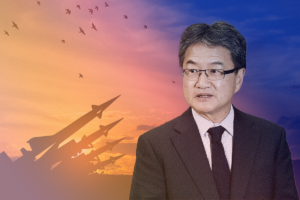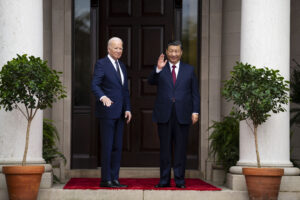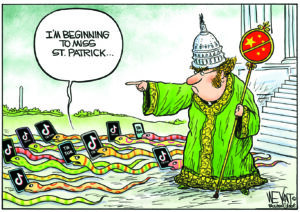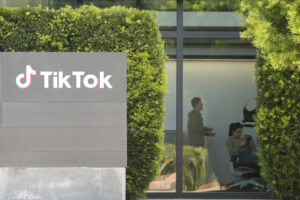The Political Myth Undergirding Peace in the Taiwan Strait
A growing number of young Taiwanese are claiming imaginary non-Chinese heritage. Peace in the region rests on a far more dangerous fiction. Taiwanese Vice President Lai Ching-te, also known as William Lai, left, celebrates his victory with running mate Bi-khim Hsiao in Taipei, Taiwan, Saturday, Jan. 13, 2024. The Ruling-party candidate has emerged victorious in Taiwan's presidential election and his opponents have conceded. (Photo: AP Photo/Louise Delmotte)
Taiwanese Vice President Lai Ching-te, also known as William Lai, left, celebrates his victory with running mate Bi-khim Hsiao in Taipei, Taiwan, Saturday, Jan. 13, 2024. The Ruling-party candidate has emerged victorious in Taiwan's presidential election and his opponents have conceded. (Photo: AP Photo/Louise Delmotte)
The January election in Taiwan has produced another stalemate. Incoming President William Lai of the Democratic Progressive Party — whose victory was widely reported in the West as “a blow to China” — will lead a minority government and be forced to compromise with the Kuomintang, or KMT, alleged to be “pro-China,” and the more neutral Taiwan People’s Party, which campaigned on domestic economic issues.
Although DPP maintains a pro-independence agenda — Beijing refuses to deal with the party — the results ensure the issue of independence will remain firmly on the back burner. This would accord with China’s preference. Following last month’s election, Chen Binhua of China’s Taiwan Affairs Office warned the Taiwanese to stick to the “1992 consensus,” without which dialogue and cooperation would be impossible and “China’s Taiwan” would be placed on a “dangerous path.”
There is just one problem: This “1992 consensus” doesn’t exist. It is a term coined by a Chinese official, Su Chi, in April 2000, referring to a meeting between Chinese Communist Party and KMT officials that took place in November 1992. Chinese and Taiwanese officials have always offered very different accounts of what happened at that meeting.
In the Chinese telling, the KMT, then in government, accepted the “One China” principle, meaning that they endorsed China’s stated policy of peaceful integration and unification. The KMT, on the other hand, say that the agreement was “One China, different interpretations,” and put quite a different spin on the meaning of “One China.” Three months before the meeting, the Mainland Affairs Council of the Republic of China (Taiwan’s official name) said that Taipei “considers ‘one China’ to mean the Republic of China, founded in 1911 and with de jure sovereignty over all of China.”
Beijing has refused to deal with the Taiwanese government for the last eight years because the DPP now says that there was never any agreement.
So as far as the KMT was concerned, the unification was supposed to go the other way, with Taiwan’s KMT government displacing Mao’s Communist Party and taking over the whole of the mainland. Under its leader, Generalissimo Chiang Kai-shek, the KMT had fled to Taiwan in 1949 to set up a one-party state and military government, but still claimed to be the legitimate government of China. The United States chose to support this preposterous claim, and until 1971, the ROC had a permanent seat on the U.N. Security Council on that basis, although in fact it always voted with the U.S.
During this period, the KMT oversaw huge economic development with American support. In 1971, when Kissinger and Nixon switched to recognizing the Communist Party’s rule over China, and the People’s Republic took over Taiwan’s Security Council seat, the KMT continued as the party of an entrenched and very rich business elite with large-scale petrochemical, electronics and other corporate interests run through the party. This made the KMT the richest political party in the world and is the origin of today’s prosperity.
It is difficult, then, to see how these contradicting views amount to a consensus. Indeed, Beijing has refused to deal with the Taiwanese government for the last eight years because the DPP now says that there was never any agreement. The largely fictitious 1992 compromise — at best an agreement that both sides could meet on neutral ground to state their differing positions — remains the only diplomatic mechanism they have ever been able to agree on. It also remains the official position of the KMT, even though this empty formula looks increasingly like a dead duck domestically, which is why they kept quiet about it during their recent unsuccessful Presidential campaign. Xi Jinping has endorsed it, claiming that it proves that the Taiwanese want the same “one China, two systems” concept that doomed Hong Kong.
There are signs that the persistence of this obvious lie is steadily alienating the Taiwanese. According to polls, the population increasingly feels more “Taiwanese” and less “Chinese,” including the 12% of the population descended from the mainland Chinese who arrived with the KMT in 1949.
The question of identity is a tricky and dynamic one in Taiwan politics. To get votes, politicians have to appear Taiwanese while doing their best not to antagonize Beijing. For instance, in the recent election campaign, the KMT candidate, Hou Yu-ih, made a point of speaking in a heavy “Taiwanese” accent. But this local dialect is not native to Taiwan. It is a Southern Min dialect from the mainland’s Fujian region that faces Taiwan; it became established through several centuries of colonial emigration from China that displaced and marginalized the native population so completely that this regional Chinese dialect now appears to be the island’s native tongue.
With the growing appetite for a separate Taiwanese identity based on democracy, there is also growing interest in appropriating the identity of the aboriginal “Formosan” population. Indeed, many ethnic Chinese in Taiwan claim to have some aboriginal blood. One of them was the activist and independence supporter Marie Lin, who claimed to have proved that 85% of Taiwanese had some aboriginal DNA and that the finding justifies forming a “Taiwanese people group” that is “distinct from the Han Chinese population.” Ridiculed by geneticists, her claims resonate with younger people looking for a way out of being simply Chinese.
The Election Study Center of Taiwan’s National Chengchi University has tracked the issue of national identity. In 1992, the predominant identity was “both Taiwanese and Chinese” (46%). Exclusively Taiwanese and exclusively Chinese tracked at 17% and 25%; those considering themselves “Chinese only” were most in favor of reunification. Over 30 years, the trends are clear. The percentage identifying as “Chinese only” has been in decline, stabilizing at about 4% in 2010. The “dual identity” option is still fairly popular at 30%. But the “Taiwanese only” identity has moved steadily upwards, year by year, passing dual identity in 2007 and achieving a current level of 62% support.
Meanwhile, in September of last year, the Taiwanese Public Opinion Foundation measured 49% of the population as pro-independence, with young people and DPP voters overwhelmingly pro-independence. Michael You, chairman of the Foundation, adds that if you ask their preference in the event that the status quo becomes unsustainable, “59% of Taiwanese are pro-independence.” Many KMT voters, not wanting to antagonize Beijing, still support the political fiction of the 1992 consensus, and Taiwan People’s Party voters split evenly on the issue. This unique political balance is the basis of the long-running electoral stalemate.
But no matter how Taiwan’s political leaders may try to spin it, one thing is clear: Beijing doesn’t like it. And eventually, something will have to give.
Although China has called William Lai a “destroyer of peace,” the President-elect is not a revolutionary, or even a rabble-rouser. His main election promise was to continue the policies of his two-term predecessor, Tsai Ing-Wen, including “cooperation with China.” His spokesman during the campaign, Vincent Chao, speaking in Taipei on Jan. 17, said, “We are the party of the status quo. It’s going to be an administration of continuation. There’s going to be no surprises. We do want to have some sort of relationship with Beijing.” But the genie of independence talk seems to be out of the bottle. Chao continues: “The people of Taiwan are walking firmly on this path that we’ve been on, which is that there’s convergence on this idea that we are already a sovereign, independent country. There’s no need to declare independence.”
Lai, who won only 40% of the vote, was elected thanks to the third-party spoiler success of the TPP, which is a one-man populist movement taking no particular position on relations with China. It has succeeded in attracting young voters through a combination of its leader’s star power and promises to address domestic economic problems.
The DPP’s offer is to protect the meaningless status quo; the KMT is tied to policies now 50 years out of date.
Not surprisingly, the KMT’s interpretation is rather different. “In the Legislative Yuan, no party gets a simple majority, so it can be interpreted as the majority of the people wanting to have a better relationship with mainland China,” said Chen-Dong Tso of National Taiwan University, foreign policy adviser to the KMT’s election campaign. “The TTP also takes a pragmatic approach to mainland China when it comes to cross-Strait relations, and [its leader] Ko Wen-je even said that both sides across the Taiwan Strait belong to one family. I think that kind of rhetoric seems to be welcomed by mainland China.”
It is the generational change they represent that is the big question. The DPP’s offer is to protect the meaningless status quo; the KMT is tied to policies now 50 years out of date. Young people in Taiwan can no more imagine living under Chinese Communist rule than they can imagine living under the fascistic military rule of Chiang Kai-shek’s KMT, but relations with China are not their main issue. They are interested in jobs and affordable housing. The threat from China has been there so long it doesn’t feel particularly urgent.
What does all this mean for the future of Taiwan’s close relationship with Washington? Dr. Tso gives a very specific prediction for U.S.-Taiwan relations during the new administration. “The importance of the United States will become even higher, because the president-elect, William Lai has no way to restart dialogue with mainland China. The only possible way for him to manage cross-Strait relations is to work with the United States.”
Joe Biden and Antony Blinken are evidently prepared to play the game, though how effective a U.S. administration will be as a neutral go-between after its own presidential election is anyone’s guess. In his reaction to the January election results, Biden reiterated, “The United States does not support the independence of Taiwan.” As with the Sino-Taiwanese “1992 consensus,” this is a deliberate untruth that for the moment remains essential to avoid provoking a catastrophic war.
Your support matters…Independent journalism is under threat and overshadowed by heavily funded mainstream media.
You can help level the playing field. Become a member.
Your tax-deductible contribution keeps us digging beneath the headlines to give you thought-provoking, investigative reporting and analysis that unearths what's really happening- without compromise.
Give today to support our courageous, independent journalists.






You need to be a supporter to comment.
There are currently no responses to this article.
Be the first to respond.